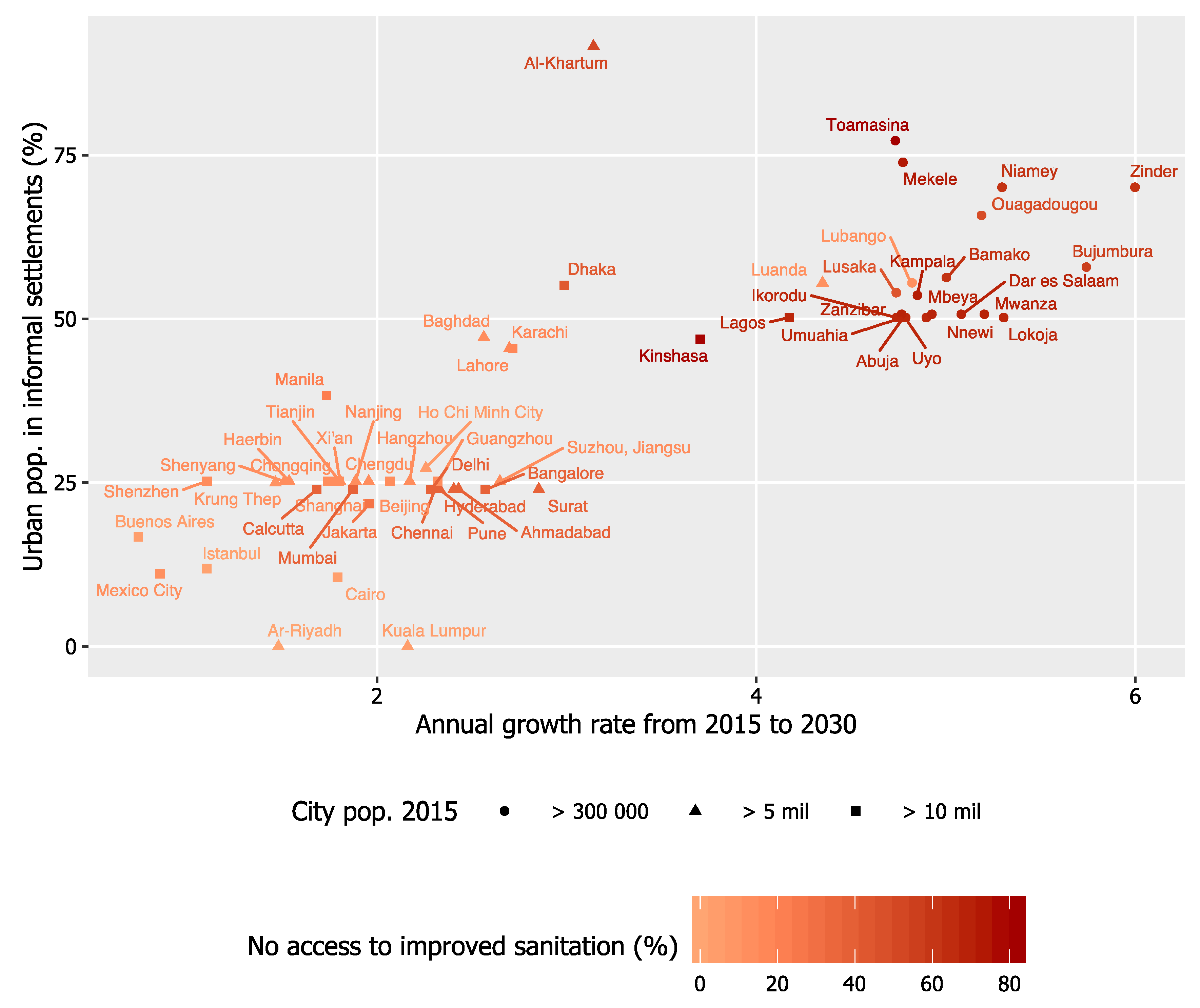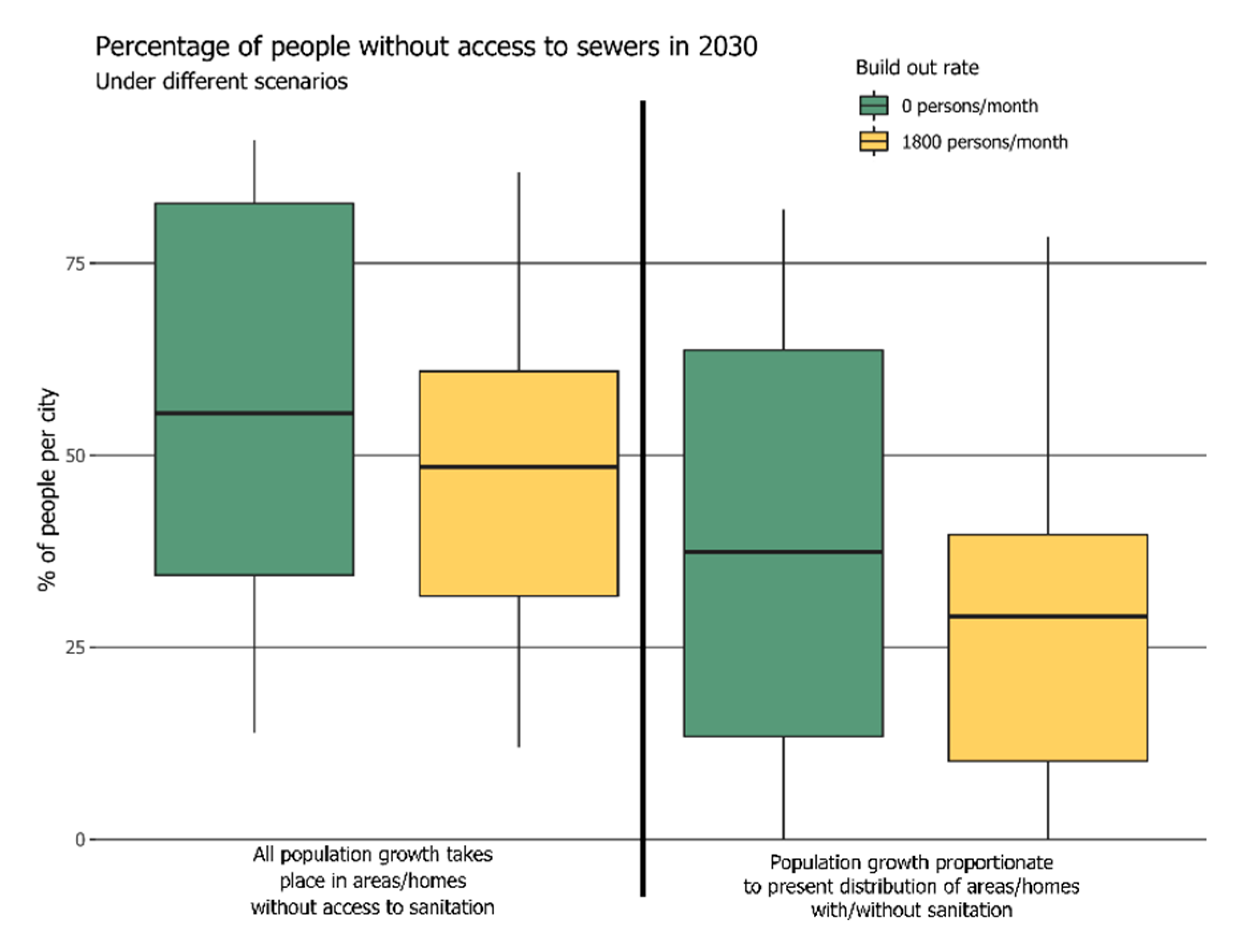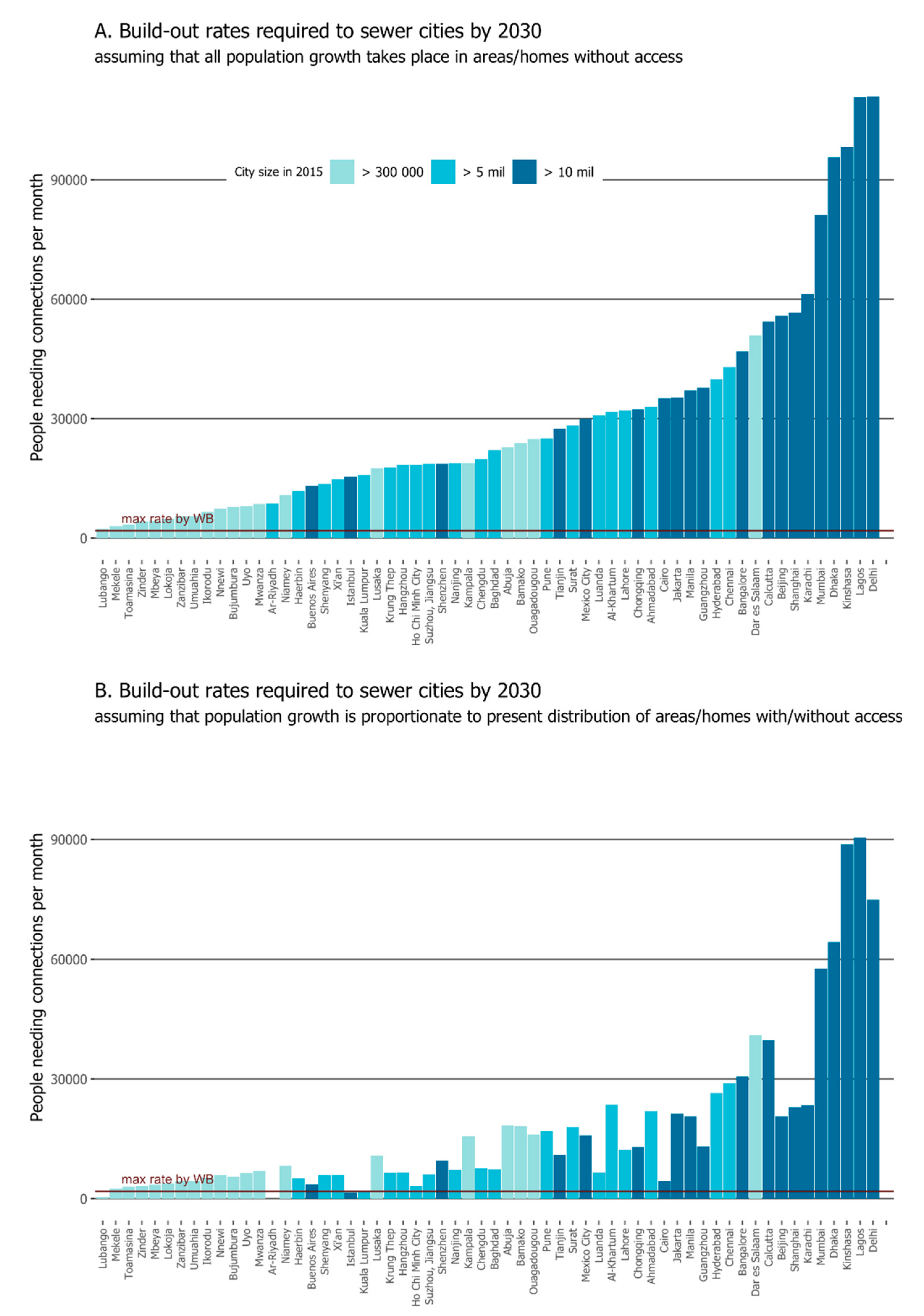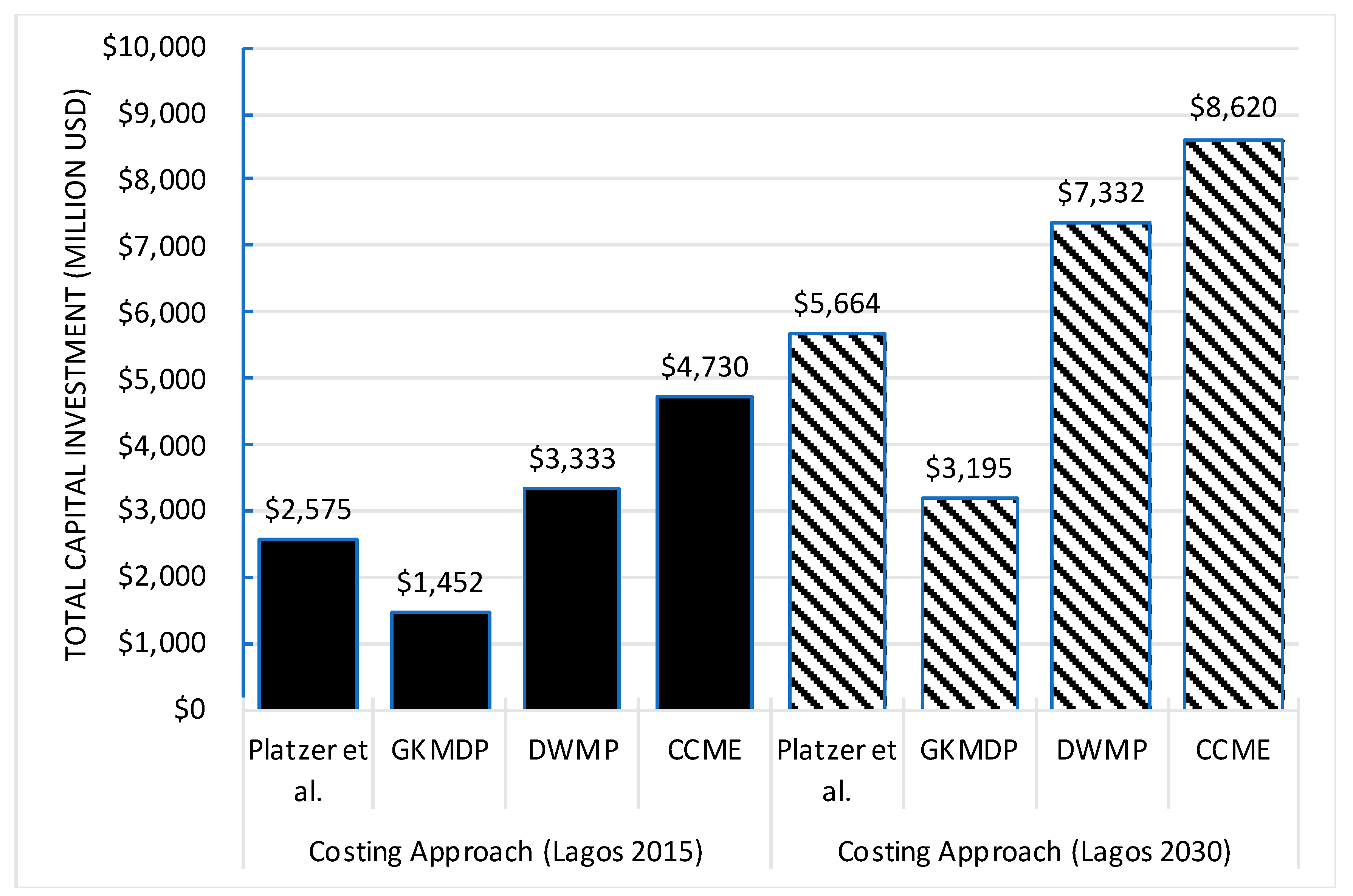Conventional Sewer Systems Are Too Time-Consuming, Costly and Inflexible to Meet the Challenges of the 21st Century
Abstract
1. Introduction
2. Materials and Methods
2.1. Estimating Urban Growth Rates and Sanitation Coverage
2.2. Estimating the Time It Takes to Provide Conventional Sewerage
- The baseline, i.e., the number of people with access to improved sanitation facilities at the start of the project;
- The number of people with access to improved sanitation facilities at the end of the project;
- The target, i.e., the number of people who were expected to be provided with access to improved sanitation facilities under the project; and
- The date on which each of the baseline values is measured and the end date of each project.
2.3. Estimating the Cost of Providing Conventional Sewerage
2.3.1. Case-Study: Lagos, Nigeria
2.3.2. Estimating the Cost of Providing Conventional Sewerage Coverage for Lagos
- Costing approach #1 utilizes the estimated build-out costs for providing water-borne sanitation to approximately 40,000 inhabitants living in 10,000 households in a peri-urban settlement outside Lima, Peru [27]. The assumptions are carefully laid out and described in detail in the original paper; for example, the system considered by the authors uses lagoons for treatment. The costs estimated in this study vary from 1038 USD to 1227 USD per household, and include water provisioning. We scaled these costs to Lagos, using the higher cost estimate to account for uncertainty in constructing similar projects in Lagos, assuming five persons per household [28] and that there were 8.8 million people that needed new connections in 2015 and 19.4 million people in 2030. Population estimates were based on the World Bank estimates of the population in underserviced areas in 2015 and 2030, respectively. As noted by an anonymous reviewer, there are limitations in viewing cost as a relationship to population size, so all population-based costing, including those provided by Platzer et al. [27], should be viewed as rough estimates and subject to localized marginal costing.
- Costing approaches #2 and 3 draw on the cost estimates for two conventional sewage projects: The GKMDP in India [29], reporting the construction of a wastewater treatment facility (with unknown treatment details) and sewerage network for South and East Guwahati. This project cost is estimated at 165 Million USD, providing services for 10.10 lakhs (1 million) people by 2020. The third, DWMP in Mongolia [30], is an ongoing Asian Development Bank supported project providing new treatment services and sewer network expansion for 50,000 residents at a total project cost of 18.9 million USD. For both of these costing approaches, we estimated the per capita cost and scaled these costs to Lagos’ 2015 and 2030 underserviced populations.
- Costing approach #4 is included as a point of comparison for the case-based cost-approaches. This estimate is based on costing templates developed for the provision of sewers and treatment plants in Canada [31], and are thus based on the admittedly unrealistic assumption that it is possible to build sewers and treatment plants in Lagos at the same cost as in Canada. These cost estimates include the construction of a new treatment plant meeting primary treatment levels required to remove suspended solid waste and biochemical oxygen demand by 35%. Needed piping requirements for estimating collection system requirements for Lagos were derived using known pipe segments for the City of Calgary (personal communication the City of Calgary), proportioning the distribution of pipes from Calgary to Lagos (for details underlying the calculations, see Table S4).
3. Results
3.1. Urban Growth Rates and Sanitation Coverage
3.2. Characterizing the Build-Out Times for Providing Conventional Sewer Systems to the Entire Population of Selected Cities by 2030
3.3. Characterizing the Cost for Providing Conventional Sewer Systems to the Entire Population in Lagos by 2030
4. Discussion
5. Conclusions
- (1)
- can be built sufficiently quickly,
- (2)
- are flexible, and
- (3)
- affordable.
Supplementary Materials
Author Contributions
Funding
Conflicts of Interest
References
- Andersson, K.; Dickin, S.; Rosemarin, A. Towards “Sustainable” Sanitation: Challenges and Opportunities in Urban Areas. Sustainability 2016, 8, 1289. [Google Scholar] [CrossRef]
- Tilley, E.; Strande, L.; Lüthi, C.; Mosler, H.-J.; Udert, K.M.; Gebauer, H.; Hering, J.G. Looking beyond technology: An integrated approach to water, sanitation and hygiene in low income countries. Environ. Sci. Technol. 2014, 48, 9965–9970. [Google Scholar] [CrossRef] [PubMed]
- Katukiza, A.Y.; Ronteltap, M.; Niwagaba, C.B.; Foppen, J.W.A.; Kansiime, F.; Lens, P.N.L. Sustainable sanitation technology options for urban slums. Biotechnol. Adv. 2012, 30, 964–978. [Google Scholar] [CrossRef] [PubMed]
- Ormerod, K.J. Illuminating elimination: Public perception and the production of potable water reuse. Wiley Interdiscip. Rev. Water 2016. [Google Scholar] [CrossRef]
- Black, M.; Fawcett, B. The Last Taboo: Opening the Door on the Global Sanitation Crisis; Routledge: Boca Raton, FL, USA, 2010; p. 272. [Google Scholar]
- UN-Habitat. Planning Sustainable Cities: Global Report on Human Settlements 2009; Routledge: Boca Raton, FL, USA, 2016. [Google Scholar]
- Mahabir, R.; Crooks, A.; Croitoru, A.; Agouris, P. The study of slums as social and physical constructs: Challenges and emerging research opportunities. Reg. Stud. Reg. Sci. 2016, 3, 399–419. [Google Scholar] [CrossRef]
- Pruss-Ustun, A.; Bos, R.; Gore, F.; Bartram, J. Safer Water, Better Health: Costs, Benefits and Sustainability of Interventions to Protect and Promote Health; World Health Organization: Geneva, Switzerland, 2008. [Google Scholar]
- Andersson, K.; Otoo, M.; Nolasco, M. Innovative sanitation approaches to address multiple development challenges. Water Sci. Technol. 2017, 77, 855–858. [Google Scholar] [CrossRef]
- Cutler, D.; Miller, G. The role of public health improvements in health advances: The twentieth-century United States. Demography 2005, 42, 1–22. [Google Scholar] [CrossRef]
- Lofrano, G.; Brown, J. Wastewater management through the ages: A history of mankind. Sci. Total Evrion. 2010, 408, 5254–5264. [Google Scholar] [CrossRef]
- George, R. The Big Necessity: The Unmentionable World of Human Waste and Why It Matters; Picador: London, UK, 2014. [Google Scholar]
- Isunju, J.; Schwartz, K.; Schouten, M.; Johnson, W.; van Dijk, M.P. Socio-economic aspects of improved sanitation in slums: A review. Public Health 2011, 125, 368–376. [Google Scholar] [CrossRef]
- Smit, S.; Musango, J.K.; Kovacic, Z.; Brent, A.C. Conceptualising slum in an urban African context. Cities 2017, 62, 107–119. [Google Scholar] [CrossRef]
- Peal, A.; Evans, B.; Blackett, I.; Hawkins, P.; Heymans, C. Fecal sludge management (FSM): Analytical tools for assessing FSM in cities. J. Water Sanit. Hyg. Dev. 2014, 4, 371–383. [Google Scholar] [CrossRef]
- Larsen, T.A.; Hoffmann, S.; Lüthi, C.; Truffer, B.; Maurer, M. Emerging solutions to the water challenges of an urbanizing world. Science 2016, 352, 928–933. [Google Scholar] [CrossRef] [PubMed]
- Hutchings, P.; Johns, M.; Jornet, D.; Scott, C.; Van den Bossche, Z. A systematic assessment of the pro-poor reach of development bank investments in urban sanitation. J. WaterSanit. Hyg. Dev. 2018, 8, 402–414. [Google Scholar] [CrossRef]
- The World Bank. Population Living in Slums (% of Urban Population)|Data. Available online: http://data.worldbank.org/indicator/EN.POP.SLUM.UR.ZS?display=default252020&end=2014&start=1990&view=chart (accessed on 24 August 2019).
- The World Bank. Urban Development|Data. Available online: http://data.worldbank.org/topic/urban-development (accessed on 24 August 2019).
- UN-Habitat. State of the World’s Cities 2012/2013; United Nations Human Settlements Programme: Nairobi, Kenya, 2013.
- United Nations Department of Economic and Social Affairs. World Urbanization Prospects: The 2014 Revision, Highlights. Available online: https://esa.un.org/unpd/wup/publications/files/wup2014-highlights.Pdf (accessed on 9 June 2019).
- Kunnuji, M. Spatial variations in access to improved sanitation and water in Lagos state. J. Water Sanit. Hyg. Dev. 2014, 4, 612–619. [Google Scholar] [CrossRef]
- Gandy, M. Learning from Lagos. New Left Rev. 2005, 33, 37. [Google Scholar]
- Adelekan, I.O. Vulnerability of poor urban coastal communities to flooding in Lagos, Nigeria. Environ. Urban. 2010, 22, 433–450. [Google Scholar] [CrossRef]
- Barredo, J.I.; Demicheli, L.; Lavalle, C.; Kasanko, M.; McCormick, N. Modelling future urban scenarios in developing countries: An application case study in Lagos, Nigeria. Environ. Plan. B 2004, 31, 65–84. [Google Scholar] [CrossRef]
- Gandy, M. Planning, anti-planning, and the infrastructure crisis facing metropolitan Lagos. In Cities in Contemporary Africa; Springer: Berlin/Heidelberg, Germany, 2006; pp. 247–264. [Google Scholar]
- Platzer, C.; Hoffmann, H.; Ticona, E. Alternatives to Waterborne Sanitation–a Comparative Study–Limits and Potentials. In Proceedings of the IRC Symposium: Sanitation for the Urban Poor, Delft, The Neatherlands, 19–21 November 2008. [Google Scholar]
- Amao, J.; Oluwatayo, I.; Osuntope, F. Economics of fish demands in Lagos state, Nigeria. J. Hum. Ecol. 2006, 19, 25–30. [Google Scholar] [CrossRef][Green Version]
- Government of Assam. JICA Assisted Guwahati Sewerage Project. Available online: https://gmdwsb.assam.gov.in/portlets/jica-assisted-guwahati-sewerage-project (accessed on 23 June 2019).
- Asian Development Bank. Mongolia: Darkhan Wastewater Management Project. Available online: https://www.adb.org/projects/37697-025/main#project-pds (accessed on 23 June 2019).
- Canadian Council of Ministers of the Environment. User Guidance for the Wastewater Treatment and Collection System Costing Templates. Available online: https://www.ccme.ca/files/Resources/municipal_wastewater_efflent/cost_template_user_guide_e.pdf (accessed on 27 April 2019).
- Wu, G.; Miao, Z.; Shao, S.; Jiang, K.; Geng, Y.; Li, D.; Liu, H. Evaluating the construction efficiencies of urban wastewater transportation and treatment capacity: Evidence from 70 megacities in China. Resour. Conserv. Recycl. 2018, 128, 373–381. [Google Scholar] [CrossRef]
- Lagos State Government. Ministry of Economic Planning and Budget. Available online: http://mepb.lagosstate.gov.ng/ (accessed on 27 April 2019).
- UN Water and WHO. Financing Universal Water, Sanitation, and Hygine Under the Sustainable Development Goals. In GLAAS 2017 Report; World Health Organization: Geneva, Switzerland, 2017. [Google Scholar]
- US EPA. Clean Watersheds Needs Survey (CWNS)—2012 Report and Data. Available online: https://www.epa.gov/cwns/clean-watersheds-needs-survey-cwns-2012-report-and-data (accessed on 27 April 2019).
- The World Bank. GDP (Current US$). Available online: https://data.worldbank.org/indicator/NY.GDP.MKTP.CD?locations=US (accessed on 27 April 2019).
- Metro Vancouver. Available online: http://www.metrovancouver.org/ (accessed on 27 April 2019).
- Asian Development Bank. Meeting Asia’s Infrastructure Needs. Available online: http://dx.doi.org/10.22617/FLS168388-2 (accessed on 23 June 2019).
- Biswas, A.K. Water Management for Major Urban Centres. Water Resour. Dev. 2006, 22, 183–197. [Google Scholar] [CrossRef]
- Varis, O.; Biswas, A.K.; Tortajada, C.; Lundqvist, J. Megacities and Water Management. Int. J. Water Resour. Dev. 2006, 22, 377–394. [Google Scholar] [CrossRef]
- Alberti, M. Grand Challenges in Urban Science. Front. Built Environ. 2017, 3. [Google Scholar] [CrossRef]
- Singh, R. Delays and cost overruns in infrastructure projects: Extent, causes and remedies. Econ. Political Wkly. 2010, 45, 43–54. [Google Scholar]
- Landers, J.; John, L. Death and the Metropolis: Studies in the Demographic History of London, 1670–1830; Cambridge University Press: Cambridge, UK, 1993; Volume 20. [Google Scholar]
- WHO. Urban Population Growth. Available online: http://www.who.int/gho/urban_health/situation_trends/urban_population_growth_text/en/ (accessed on 27 April 2019).
- Baker, J.L. Climate Change, Disaster Risk, and the Urban Poor: Cities Building Resilience for a Changing World; World Bank Publications: Washington, DC, USA, 2012. [Google Scholar]
- Ayuero, J.; Swinstun, D.A. Flammable: Environmental Suffering in an Argentine Shantytown; Oxford University Press: Oxford, UK, 2009. [Google Scholar]
- Cirelli, A.F.; Ojeda, C. Wastewater management in Greater Buenos Aires, Argentina. Desalination 2008, 218, 52–61. [Google Scholar] [CrossRef]
- Ordoqui Urcelay, M.B. Servicios de Agua Potable y Alcantarillado en la Ciudad de Buenos Aires, Argentina: Factores Determinantes de la Sustentabilidad y el Desempeño; CEPAL: Santiago, Chile, 2007. [Google Scholar]
- Vitousek, S.; Barnard, P.L.; Fletcher, C.H.; Frazer, N.; Erikson, L.; Storlazzi, C.D. Doubling of coastal flooding frequency within decades due to sea-level rise. Sci. Rep. 2017, 7, 1399. [Google Scholar] [CrossRef] [PubMed]
- Oberg, G.; del Carmen Morales, M. The Idea of Sewage as a Resource: An Introductory Study of Knowledge and Decision Making in Liquid Waste Management in Metro Vancouver, BC. Canada. In Program on Water Governance; University of British Columbia: Vancouver, BC, Canada, 2012; pp. 1–46. [Google Scholar]
- Stubblefield, W.; Servos, M.R.; Gersberg, R.M.; Riley, C.; Simpson, D.; Smith, D.; Wells, P. Scientific and Technical Review. Capital Regional District Core Area Liquid Waste Management Plan. 2006. Available online: https://www.crd.bc.ca/docs/default-source/seaterra-pdf/related-articles/scientificandtechnicalreview.pdf (accessed on 27 April 2019).
- Gandy, M. Rethinking urban metabolism: Water, space and the modern city. City 2004, 8, 363–379. [Google Scholar] [CrossRef]
- Brown, R.R.; Keath, N.; Wong, T.H.F. Urban water management in cities: Historical, current and future regimes. Water Sci. Technol. 2009, 59, 847–855. [Google Scholar] [CrossRef]
- Brands, E. Prospects and challenges for sustainable sanitation in developed nations: A critical review. Environ. Rev. 2014, 22, 346–363. [Google Scholar] [CrossRef]
- Bhagwan, J.; Still, D.; Buckley, C.; Foxon, K. Challenges with up-scaling dry sanitation technologies. Water Sci. Technol. 2008, 58, 21–27. [Google Scholar] [CrossRef]
- Rosenquist, L.E.D. A psychosocial analysis of the human-sanitation nexus. J. Environ. Psychol. 2005, 25, 335–346. [Google Scholar] [CrossRef]
- McGranahan, G.; Mitlin, D. Learning from Sustained Success: How Community-Driven Initiatives to Improve Urban Sanitation Can Meet the Challenges. World Dev. 2016, 87, 307–317. [Google Scholar] [CrossRef]
- Berndtsson, J.C.; Hyvönen, I. Are there sustainable alternatives to water-based sanitation system? Practical illustrations and policy issues. Water Policy 2002, 4, 515–530. [Google Scholar] [CrossRef]
- McFarlane, C. Sanitation in Mumbai’s informal settlements: State, ‘slum’, and infrastructure. Environ. Plan. A 2008, 40, 88–107. [Google Scholar] [CrossRef]
- Orner, K.D.; Mihelcic, J.R. A review of sanitation technologies to achieve multiple sustainable development goals that promote resource recovery. Environ. Sci. Water Res. Technol. 2018, 4, 16–32. [Google Scholar] [CrossRef]
- Pradel, M.; Aissani, L.; Villot, J.; Baudez, J.-C.; Laforest, V. From waste to added value product: Towards a paradigm shift in life cycle assessment applied to wastewater sludge—A review. J. Clean. Prod. 2016, 131, 60–75. [Google Scholar] [CrossRef]
- Galli, G.; Nothomb, C.; Beatings, E. Towards Systemic Change in Urban Sanitation; IRC: The Hague, The Netherlands, 2014; pp. 1–36. [Google Scholar]
- Guest, J.S.; Skerlos, S.J.; Barnard, J.L.; Beck, M.B.; Daigger, G.T.; Hilger, H.; Jackson, S.J.; Karvazy, K.; Kelly, L.; Macpherson, L.; et al. A New Planning and Design Paradigm to Achieve Sustainable Resource Recovery from Wastewater. Evrion. Sci. Technol. 2009, 43, 6126–6130. [Google Scholar] [CrossRef]
- Orth, H. Centralised versus decentralised wastewater systems? Water Sci. Technol. 2007, 56, 259–266. [Google Scholar] [CrossRef] [PubMed][Green Version]
- Andersson, K. Sanitation, Wastewater Management and Sustainability: From Waste Disposal to Resource Recovery. In UN Environmental Programme Global Programme of Action for the protection of the Marine Environment from Land Based Activities; Stockholm Environment Institute (SEI): Stockholm, Sweden, 2016. [Google Scholar]
- Balkema, A.J.; Preisig, H.A.; Otterpohl, R.; Lambert, F.J. Indicators for the sustainability assessment of wastewater treatment systems. Urban. Water 2002, 4, 153–161. [Google Scholar] [CrossRef]
- Massoud, M.A.; Tarhini, A.; Nasr, J.A. Decentralized approaches to wastewater treatment and management: Applicability in developing countries. J. Evrion. Manag. 2009, 90, 652–659. [Google Scholar] [CrossRef]
- Schoen, M.E.; Xue, X.; Wood, A.; Hawkins, T.R.; Garland, J.; Ashbolt, N.J. Cost, energy, global warming, eutrophication and local human health impacts of community water and sanitation service options. Water Res. 2017, 109, 186–195. [Google Scholar] [CrossRef]
- Roefs, I.; Meulman, B.; Vreeburg, J.H.G.; Spiller, M. Centralised, decentralised or hybrid sanitation systems? Economic evaluation under urban development uncertainty and phased expansion. Water Res. 2017, 109, 274–286. [Google Scholar] [CrossRef]
- Schmitt, R.J.P.; Morgenroth, E.; Larsen, T.A. Robust planning of sanitation services in urban informal settlements: An analytical framework. Water Res. 2017, 110, 297–312. [Google Scholar] [CrossRef]
- Narayanan, N.; Ray, I.; Gopakumar, G.; Argade, P. Towards sustainable urban sanitation: A capacity-building approach to wastewater mapping for small towns in India. J. Water Sanit. Hyg. Dev. 2017, 8, 227–237. [Google Scholar] [CrossRef]
- Tsinda, A.; Abbott, P.; Pedley, S.; Charles, K.; Adogo, J.; Okurut, K.; Chenoweth, J. Challenges to Achieving Sustainable Sanitation in Informal Settlements of Kigali, Rwanda. Int. J. Environ. Res. Public Health 2013, 10, 6939. [Google Scholar] [CrossRef] [PubMed]
- Parkinson, J.; Tayler, K. Decentralized wastewater management in peri-urban areas in low-income countries. Wastewater Manag. 2003, 15, 75–89. [Google Scholar]
- Van Welie, M.J.; Romijn, H.A. NGOs fostering transitions towards sustainable urban sanitation in low-income countries: Insights from transition management and development studies. Environ. Sci. Policy 2017, 84, 250–260. [Google Scholar] [CrossRef]
- Apple, M.W. Can Education Change Society; Routledge: Boca Raton, FL, USA, 2012. [Google Scholar]
- Shor, I. Empowering Education: Critical Teaching for Social Change; University of Chicago Press: Chicago, IL, USA, 2012. [Google Scholar]
- Westheimer, J.; Kahne, J. What kind of citizen? The politics of educating for democracy. Am. Educ. Res. J. 2004, 41, 237–269. [Google Scholar] [CrossRef]
- Brookfield, S. The power of critical theory for adult learning and teaching. Adult Learn. 2005, 85, 440. [Google Scholar]
- Anderson, W.C. A history of environmental engineering in the United States. Environ. Water Resour. Hist. 2003. [Google Scholar] [CrossRef]
- Smith, D.W.; Biswas, N. Environmental engineering education in Canada. J. Evrion. Eng. Sci. 2002, 1, 1–7. [Google Scholar] [CrossRef]
- Malina, J.F.; Gloyna, E.F. History of Environmental Engineering at the University of Texas at Austin. In Environmental and Water Resources: Milestones in Engineering History; American Society of Civil Engineers: Reston, VA, USA, 2007; pp. 36–43. [Google Scholar]
- Leonard, K.M. Brief History of Environmental Engineering: “The World’s Second Oldest Profession”. In Proceedings of the International Engineering History and Heritage, Reston, VA, USA, 10–13 October 2001; pp. 389–393. [Google Scholar]
- Logsdon, G.S. The future of environmental engineering education. J. Environ. Eng. Sci. 2008, 7, 1–4. [Google Scholar]
- Hansen, D.; Kells, J.A. Environmental engineering education in Canada: Discussion. Can. J. Civ. Eng. 2002, 29, 185–187. [Google Scholar] [CrossRef]
- Mattson, C.A.; Wood, A.E. Nine Principles for Design for the Developing World as Derived From the Engineering Literature. J. Mech. Des. 2014, 136. [Google Scholar] [CrossRef]
- Iyer-Raniga, U.; Andamon, M. Sustainability education in the engineering and built environment curriculum: The case for Asia-Pacific. In Proceedings of the 5th International Conference of Conference of Education, Research and Innovation (iCERI), Madrid, Spain, 19–21 November 2012. [Google Scholar]
- Gaulke, L.; Borgford-Parnell, J.; Stensel, H. A decentralized and onsite wastewater management course: Bringing together global concerns and practical pedagogy. Water Sci. Technol. 2008, 58, 1397–1404. [Google Scholar] [CrossRef][Green Version]
- Lofrano, G. Green Technologies for Wastewater Treatment; Springer Science & Business Media: Berlin/Heidelberg, Germany, 2012; p. 92. [Google Scholar] [CrossRef]
- Daigger, G.T. Evolving Urban Water and Residuals Management Paradigms: Water Reclamation and Reuse, Decentralization, and Resource Recovery. Water Evrion. Res. 2009, 81, 809–823. [Google Scholar] [CrossRef] [PubMed]
- Libralato, G.; Volpi Ghirardini, A.; Avezzù, F. To centralise or to decentralise: An overview of the most recent trends in wastewater treatment management. J. Evrion. Manag. 2012, 94, 61–68. [Google Scholar] [CrossRef] [PubMed]
- Hoffmann, S.; Feldmann, U.; Bach, P.M.; Binz, C.; Farrelly, M.; Frantzeskaki, N.; Hiessl, H.; Inauen, J.; Larsen, T.A.; Lienert, J. A Research Agenda for the Future of Urban Water Management: Exploring the Potential of Nongrid, Small-Grid, and Hybrid Solutions. Environ. Sci. Technol. 2020, 54, 5312–5322. [Google Scholar] [CrossRef]




| Country | Geographic Scope | Cost ($ M) | Start (Year) | Rate (Persons/Month) | |
|---|---|---|---|---|---|
| Target | Actual | ||||
| Brazil | Metropolitan Sao Paulo | 233.50 | 2007 | 461 | 251 |
| Vietnam | District towns and large urban centers | 135.00 | 2005 | 629 | 366 |
| Vietnam | Lao Cai, Vinh, and Phu Ly | 285.00 | 2011 | 2616 | 1236 |
| Vietnam | Urban areas in project provinces | 236.20 | 2011 | 804 | 1809 |
| Morocco | Selected towns in project provinces | 75.10 | 2010 | 1548 | 692 |
| Ghana | Greater Accra Metropolitan Area | 150.00 | 2013 | 3676 | 168 |
| Argentina | Province and City of Buenos Aires | 1000.00 | 2015 | 658 | 378 |
| Kenya | Nairobi City, Mombasa, Coastal, and Nzoia Region | 159.31 | 2011 | 23 | 78 |
| Ethiopia | Addis Ababa and four secondary cities. | 119.00 | 2012 | 22,319 | 1568 |
| Vietnam | City of Quy Nhon | 26.68 | 2007 | 449 | 456 |
© 2020 by the authors. Licensee MDPI, Basel, Switzerland. This article is an open access article distributed under the terms and conditions of the Creative Commons Attribution (CC BY) license (http://creativecommons.org/licenses/by/4.0/).
Share and Cite
Öberg, G.; Metson, G.S.; Kuwayama, Y.; A. Conrad, S. Conventional Sewer Systems Are Too Time-Consuming, Costly and Inflexible to Meet the Challenges of the 21st Century. Sustainability 2020, 12, 6518. https://doi.org/10.3390/su12166518
Öberg G, Metson GS, Kuwayama Y, A. Conrad S. Conventional Sewer Systems Are Too Time-Consuming, Costly and Inflexible to Meet the Challenges of the 21st Century. Sustainability. 2020; 12(16):6518. https://doi.org/10.3390/su12166518
Chicago/Turabian StyleÖberg, Gunilla, Geneviève S. Metson, Yusuke Kuwayama, and Steven A. Conrad. 2020. "Conventional Sewer Systems Are Too Time-Consuming, Costly and Inflexible to Meet the Challenges of the 21st Century" Sustainability 12, no. 16: 6518. https://doi.org/10.3390/su12166518
APA StyleÖberg, G., Metson, G. S., Kuwayama, Y., & A. Conrad, S. (2020). Conventional Sewer Systems Are Too Time-Consuming, Costly and Inflexible to Meet the Challenges of the 21st Century. Sustainability, 12(16), 6518. https://doi.org/10.3390/su12166518






